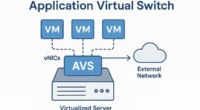Table of Contents
- What is a Metropolitan Area Network (MAN)?
- How Does a MAN Work?
- Key Features of Metropolitan Area Networks (MANs)
- Advantages of Metropolitan Area Networks
- Disadvantages of Metropolitan Area Networks
- Applications of Metropolitan Area Networks (MANs)
- 1. Business and Enterprise Connectivity
- 2. Educational Institutions
- 3. Healthcare Networks
- 4. Government and Public Services
- 5. Smart City Initiatives
- 6. Media and Entertainment
- 7. Telecommunication Services
- 8. Financial Services
- 9. Research and Development
- 10. Hospitality Industry
- 11. Sports and Entertainment Venues
- Real-World Examples
- Conclusion
What is a Metropolitan Area Network (MAN)?
A Metropolitan Area Network, or MAN, is a type of computer network that spans a city or a large campus. It’s larger than a Local Area Network (LAN), which typically covers a single building or a small group of buildings, but smaller than a Wide Area Network (WAN), which can cover entire countries or continents. MANs are designed to connect multiple LANs within a specific geographic area, facilitating efficient data communication and resource sharing among various organizations, institutions, or departments within a city.
How Does a MAN Work?
1. Core Infrastructure
The backbone of a MAN is typically built using high-capacity fiber optic cables, which provide the necessary bandwidth for rapid data transmission across the network. These cables form the central hub, interconnecting various parts of the network and ensuring data flows smoothly between different LANs. Routers and switches are strategically placed within this infrastructure to manage data flow and routing, directing data packets to their appropriate destinations.
2. Connection to Local Area Networks (LANs)
At the access layer, routers, switches, and other networking devices connect individual LANs to the MAN. This setup allows for seamless communication between different departments or organizations within the metropolitan area. The access layer is where end-users interact with the network, accessing shared resources and services.
3. Data Transmission and Routing
Data generated within a LAN is segmented into packets, each containing headers with information such as source and destination addresses. Routers within the MAN analyze these headers to determine the most efficient path for each packet to reach its destination. Switches within the LANs then forward the packets to the appropriate devices based on their Media Access Control (MAC) addresses. This process ensures that data is transmitted accurately and efficiently across the network.
4. Network Topologies
MANs can be designed using various network topologies, depending on specific requirements and design choices. Common topologies include:
- Ring Topology: Each node is connected to two neighboring nodes, forming a closed loop. Data circulates around the ring until it reaches its intended destination.
- Star Topology: All LANs connect to a central hub or switch, which acts as the central point of control and data distribution.
- Mesh Topology: Multiple interconnected paths exist between LANs, providing redundancy and fault tolerance. This topology is highly resilient but can be complex to manage.
5. Protocols and Standards
MANs utilize various networking protocols and standards to govern their operation. Some commonly used protocols include:
- Ethernet: Defines how data frames are formatted and transmitted within the network.
- Internet Protocol (IP): Used for addressing and routing packets across the MAN.
- Spanning Tree Protocol (STP): Prevents loops in network topologies, especially in ring-based MANs.
6. Network Management and Security
Effective management of a MAN is crucial for ensuring its reliability and performance. Network administrators employ various tools and protocols, such as Simple Network Management Protocol (SNMP), to monitor and control the network. Security measures, including firewalls, intrusion detection systems, and encryption, are implemented to safeguard data and prevent unauthorized access.
7. Integration with External Networks
MANs often connect to external networks, such as the internet or Wide Area Networks (WANs), to extend their reach beyond the metropolitan area. This integration involves additional routers, gateways, and connectivity services to bridge the MAN with external networks, facilitating broader communication and data exchange.
Key Features of Metropolitan Area Networks (MANs)
1. Geographic Coverage
MANs are designed to cover a metropolitan area, typically ranging from 5 to 50 kilometers. This coverage allows for the interconnection of various buildings, campuses, and commercial locations within a city, facilitating seamless communication and resource sharing among different sites.
2. High-Speed Connectivity
One of the primary features of MANs is their ability to provide high-speed data transfer rates. Utilizing technologies like fiber optics, MANs can achieve gigabit-level speeds, ensuring quick and reliable communication essential for real-time applications such as video conferencing and VoIP.
3. Interconnection of Multiple LANs
MANs serve as a bridge between multiple LANs, enabling seamless communication and resource sharing among different locations within the metropolitan area. This interconnectivity allows organizations to function cohesively across various sites.
4. Scalability
MANs are designed with scalability in mind, allowing for easy expansion as organizational needs grow. Additional devices and locations can be integrated into the existing infrastructure without significant overhauls, accommodating the evolving requirements of businesses and institutions.
5. Reliability and Redundancy
To ensure continuous operation and minimize downtime, MANs often incorporate redundancy features such as multiple data transmission paths and failover mechanisms. These measures enhance the network’s fault tolerance and reliability.
6. Centralized Management
MANs allow for centralized management of network resources, simplifying administration and maintenance tasks. This centralized approach also enhances security by enabling consistent policy enforcement across all connected sites.
7. Support for Multiple Services
MANs are versatile networks capable of supporting various services, including data, voice, and video. This versatility makes them ideal for organizations that require integrated communication solutions across different media.
8. Enhanced Security Measures
Given the broader coverage area, MANs implement robust security measures such as encryption, authentication protocols, and intrusion detection systems to safeguard data and prevent unauthorized access.
9. Integration with Other Networks
MANs can seamlessly integrate with both Local Area Networks (LANs) within the metropolitan area and Wide Area Networks (WANs) to extend connectivity beyond the city. This integration facilitates broader communication and data exchange.
10. Support for Smart City Initiatives
In the context of smart cities, MANs play a crucial role by providing the communication infrastructure necessary for connecting sensors, IoT devices, and various urban services. This connectivity supports applications like traffic management, surveillance systems, and public Wi-Fi, contributing to the overall efficiency and safety of urban environments.
Advantages of Metropolitan Area Networks
- Enhanced Communication: MANs facilitate efficient communication between different departments or organizations within a city, improving collaboration and productivity.
- Cost-Effective Resource Sharing: By sharing resources like internet connections and data storage, organizations can reduce operational costs.
- Scalability: MANs can be easily expanded to include more LANs as organizations grow or as new entities join the network.
- Improved Data Transfer Speeds: High-speed connections ensure that data is transmitted quickly, which is crucial for time-sensitive applications.
- Centralized Security Measures: With centralized management, it’s easier to implement and monitor security protocols across the network.
Disadvantages of Metropolitan Area Networks
- High Initial Setup Costs: Establishing a MAN requires significant investment in infrastructure, including cables, routers, and switches.
- Complex Maintenance: Managing a network that spans a large area can be complex and requires skilled personnel.
- Potential Security Risks: As data travels over a broader area, there’s an increased risk of unauthorized access or data breaches if proper security measures aren’t in place.
- Dependency on Service Providers: Organizations may rely on third-party service providers for certain aspects of the MAN, which can lead to issues if the provider experiences downtime or technical problems.
Applications of Metropolitan Area Networks (MANs)
1. Business and Enterprise Connectivity
MANs enable businesses with multiple office locations within a city to connect seamlessly, supporting internal communication, data sharing, and centralized IT resources. This connectivity ensures that employees across different branches can collaborate effectively, access shared applications, and maintain consistent operations.
2. Educational Institutions
Universities and colleges with multiple campuses or buildings use MANs to provide high-speed internet access, facilitate research collaborations, and support administrative functions. This interconnectedness allows students and educators to collaborate on projects, share resources, and access online educational tools without interruption.
3. Healthcare Networks
Hospitals and healthcare facilities within a metropolitan area utilize MANs to share patient records, enable telemedicine services, and connect medical devices across multiple sites. This connectivity allows for the efficient sharing of patient records, telemedicine services, and access to specialized medical resources, contributing to improved patient care and health outcomes.
4. Government and Public Services
Government agencies use MANs to connect different departments and offices, enhancing communication, data sharing, and service delivery to the public. This integration helps in creating a more connected and efficient urban infrastructure, facilitating services such as public safety communications, traffic management, and administrative data sharing.
5. Smart City Initiatives
MANs are foundational to the development of smart cities, enabling the interconnectivity of various municipal services such as traffic management, public safety monitoring, and utility services. By facilitating the seamless exchange of data between different city departments and infrastructure, MANs enhance the efficiency of city operations and improve the quality of life for residents.
6. Media and Entertainment
MANs support the distribution of digital media content, such as streaming services, broadcasting, and online gaming, by ensuring high-bandwidth connectivity between content providers and users. These networks ensure high-quality and reliable broadcasting, supporting the growth of the digital entertainment industry and enhancing the user experience.
7. Telecommunication Services
Telecommunication service providers use MANs to deliver high-speed internet and connectivity services to businesses and residential areas within metropolitan regions. These networks are essential for providing reliable and high-bandwidth internet access, supporting services such as VoIP, IPTV, and broadband internet.
8. Financial Services
In the heart of a city’s financial district, MANs power the digital arteries of financial institutions. They ensure the swift and secure transmission of stock market data, online banking transactions, and communication between financial professionals, supporting the critical operations of banks, investment firms, and trading platforms.
9. Research and Development
Research institutions, laboratories, and universities utilize MANs to support collaborative research projects. They enable the sharing of large datasets, access to high-performance computing resources, and real-time collaboration among researchers, enhancing the research capabilities and innovation potential within metropolitan areas.
10. Hospitality Industry
Hotels and resorts use MANs to offer high-speed internet and communication services to guests, enhancing their overall experience. These networks support services such as online booking systems, in-room entertainment, and seamless connectivity for conferences and events.
11. Sports and Entertainment Venues
Stadiums, arenas, and large entertainment venues rely on MANs to meet the connectivity needs of attendees and staff. This includes ticketing systems, wireless access, and security systems, ensuring smooth operations and enhanced fan experiences during events.
Real-World Examples
- Smart City Infrastructure: Cities implement MANs to connect traffic lights, surveillance cameras, and public Wi-Fi hotspots, enhancing urban management and services.
- Public Transportation Systems: MANs support communication between different transportation hubs, improving coordination and efficiency.
- Emergency Services: Police, fire departments, and emergency medical services use MANs to share information quickly during emergencies.
Conclusion
Metropolitan Area Networks play a crucial role in modern urban environments by connecting various organizations and institutions within a city. They offer high-speed communication, resource sharing, and centralized management, which are essential for efficient operations in sectors like education, healthcare, government, and business. While the initial setup and maintenance can be complex and costly, the long-term benefits of improved collaboration, cost savings, and enhanced services make MANs a valuable investment for metropolitan areas.









